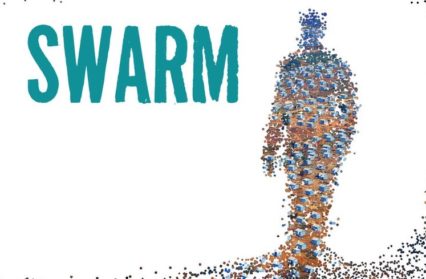“You’ve got a swarm of people coming across the Mediterranean, seeking a better life”.
David Cameron’s infamous words regarding migrants forms the tagline for this interactive site-specific performance set in Butetown History and Arts Centre – a museum and research centre which has collected, preserved and interpreted the history of immigrants and minorities in Wales for almost thirty years. The cast is comprised of a mixture of professional and community performers who have volunteered to take part in this inaugural project of newly founded charity Fio, which forms the second stage of original charity Youth of Creative Arts (YOCA), established ten years ago by Swarm director Abdul Shayek.
Swarm takes place in an alternate version of today’s world where roles have been reversed; the West is under attack, decimated by bombs, countless people struggling to escape as refugees to an East that has closed its borders. This could have been made more explicit from the outset to avoid any confusion distracting from the credibility of the scenario. The strongest aspect of the performance is the initial commitment to plunging the audience into a realistic refugee crisis. We are tersely greeted by a security guard with a clipboard:
“Take a number. Don’t lose it. If anyone asks, you’re going to the Dome.”
Huddled in a group, we are then told to make our way down the road and turn right with his final ominous instructions echoing in our ears.
“The way is clear. Stick together. Be careful.”
The atmosphere of uncertainty continues to build, reaching a climax when a burly guard forces us all into the building which forms a makeshift transit centre amidst yells there is an emergency situation. Blue tarp falls over the glass window as we are informed we are now in lockdown. One by one we are photographed against the wall before being made to present our numbers and show our hands for inspection to people wearing hospital masks. The dismissive tones used to, and about, us ensure our individuality and humanity is slowly stripped away among phrases such as “process these people”. This interactive style ensures the audience experiences a fraction of the distressing reality of being an immigrant; a far more effective technique than merely witnessing such an activity.
Actors hidden amongst the audience begin to emerge, adding some structure to the story; a harried doctor struggling with limited medical supplies, a hostile volunteer overprotective of her young wards, a resourceful reporter determined to expose the true story, a Western official caught up in the melee, a young migrant desperate to escape and a large group of children who make up the majority of the makeshift camp’s refugees. Whilst all the actors undoubtedly give their all to the performance, the dramatization sometimes spills over into the theatrical, detracting from the authenticity of the piece.
Aside from the introduction, there is little in the way of a sustainable atmosphere. There is no panic or fear which is surely a key emotion amongst refugees, and sparse instructions generates uncertainty within the audience as to whether we are in the right place or missing key aspects of the performance, rather than a realistic sense of anxiety caused by the situation, as may have been intended. The middle part of the performance lacks some cohesion as the audience are shuffled between rooms, various bits of footage and short scenes from the community performers interspersing the movement. Hindered by a lack of space not everyone is able to hear or see the action and an absence of urgency leaves this part feeling flat.
The final section takes place in a cramped room, full of mattresses and plastic chairs upon which the audience perch. More of the characters’ pasts are revealed with the key message “everyone has a story”. The children, all volunteers from the local community, settle down to draw, sticking their finished pictures on the walls. Colourful, childlike drawings of flowers are superimposed over bold, black writing detailing the number of fatalities in various countries – a pronounced and poignant contrast.
A piece such as this is undoubtedly relevant in current times, particularly in the wake of Brexit, but unfortunately, despite its array of innovative ideas and potential to hit hard, Swarm gently provokes rather than providing the gut-wrenching impact that could have been achieved when exploring such a powerful and emotional issue. One question did resound with me and unfortunately it is one Britain is still struggling to answer in response to the world’s refugees – if not yours, whose responsibility is it?












